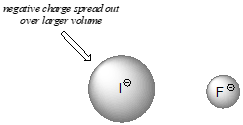3 Molecular Structure and Acid Strength
Much of this section is excerpted from Soderberg, Organic Chemistry with a Biological Emphasis, Ch. 7.4.
Previously, we have quantified acid strengths by (a) categorizing acids as strong or weak, and (b) using acid ionization constants ([latex]K_a[/latex]). We will now try and explain this based on the structures of molecules.[1] We will focus here on binary acids: acids with only two elements H and X (where X is a non-metal), with a view to understanding fundamental principles. In your organic chemistry course, you will extend this to a greater range of molecules using similar principles.
The Trend
The acid strength of binary compounds of hydrogen with nonmetals (A) increases as the H-A bond strength decreases down a group in the periodic table. For group 17, the order of increasing acidity is HF < HCl < HBr < HI. Likewise, for group 16, the order of increasing acid strength is H2O < H2S < H2Se < H2Te.
Across a row in the periodic table, the acid strength of binary hydrogen compounds increases with increasing electronegativity of the nonmetal atom because the polarity of the H-A bond increases. Thus, the order of increasing acidity (for removal of one proton) across the second row is CH4 < NH3 < H2O < HF; across the third row, it is SiH4 < PH3 < H2S < HCl
Explaining The Trend
The key to understanding this trend is to consider the hypothetical conjugate base in each case: the more stable (weaker) the conjugate base, the stronger the acid. In each case, the negative charge falls on the non-hydrogen atom.
In this paradigm, the increasing strength as we move from left to right along a row of the periodic table can be understood by recognizing that the electronegativity would also increase. As a result, the conjugate base ([latex]\mbox{X}^-[/latex] would take more of the negative charge. However, as you may recall, the electronegativities of atoms decrease as you go down a periodic table, making it seem counterintuitive. This is one case where there are multiple factors that play into explaining phenomena, and the key is to identify the most important factor(s) that explain the phenomenon.
It turns out that when moving vertically in the periodic table, the size of the atom is more important than its electronegativity with regard to basicity. The atomic radius of iodine is approximately twice that of fluorine, so in an iodide ion, the negative charge is spread out over a significantly larger volume. Electrostatic charges, whether positive or negative, are more stable when they are ‘spread out’ over a larger area; this means, in turn, that the conjugate base is more stable and the acid is therefore stronger as the conjugate base becomes larger.

- For bases, you can follow the same logic by recalling that the strength of bases are inversely related to the strengths of their conjugate acids. ↵
